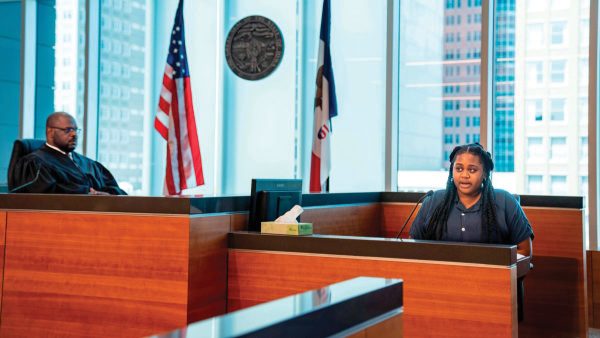How to get your security deposit back
Apr 22, 2019
Editor’s Note: This guest column was submitted by Aspen Olsen, an AmeriCorps member with the Waterloo Regional Office of Iowa Legal Aid. It was written by Cara Strike.
The final days of the school year are quickly upon us. What does this mean? Finals and then summer break is just around the corner, and your leases are coming to an end. No one wants to go through the stress of being told that their security deposit is not being refunded.
Let’s face it, sometimes inevitable damage to a rental property occurs. However, there are many simple steps that you can take to help protect your rental deposit. Some of these ideas may seem a bit excessive. For most of you, they will be unnecessary. But in the event that an incident does occur, going through these steps may save you a lot of time, energy, and most importantly MONEY!
Move-in tips:
• Rather than being assigned the culprit of any damage, make a list of any issues with the property that are already there when you move in. This list should be made as you are moving in, or before. Problems can be more than a ding in the wall or a broken window blind. They can also include stains in the carpet or a door that will not close properly. If possible, your landlord should help you make the list. It is also a good idea to bring a friend along and snap a few pictures.
• After your list is finalized, you and your landlord should each sign it. Each of you should keep a copy.
• When you pay your security deposit, be sure to keep the receipt. The receipt should indicate that it is for a rental deposit, and it should say the amount and date of when it was received.
What if something happens while you’re living there?
• Take a deep breath. Then tell the landlord about the damage right away – in writing! The cause of the damages should be explained. Remember that the tenant is responsible only if the tenant or the tenant’s guest is somehow at fault.
Move-out day:
• Give the proper notice when you want to move out and keep a copy of it for your records.
• Put the place back in shape. This means removing trash and leaving the property in the same or better condition than when you moved in.
• Arrange a meeting with your landlord when you move out. Go through the checklist that you made when you moved into the property. Try to determine what expenses (if any) you will be charged for (this may include cleaning fees or damage repair). Asking these questions may put you in a position to fix the damage before moving out – ultimately saving you some cash. If your landlord can state no reason for keeping part or all of your deposit, ask to get your deposit back during this meeting. If your landlord will not meet for a walkthrough, then ask the city inspector or a friend to do one with you.
• Take focused pictures of the unit before you leave and make sure that you can prove the date it was taken. In most cases, a picture is worth 1,000 words.
• When you move out, give your landlord an updated mailing address – in writing! Keep a dated copy of your notice of address change. If no mailing address is given to the landlord within one year, the tenant loses the right to get any of their deposit back.
• Keep in mind that the landlord must return the tenant’s security deposit and/or give an itemization of damages within 30-days after the tenant has moved out and given a forwarding address, or else the landlord does not have a right to keep any of your deposit. The tenant may also be able to recover up to twice the rental payment if the landlord is not being fair.
The steps that you can take to best protect yourself are often the most simple. Document everything that you do in writing. This can be by email, text, or letter (however, please be aware that official notices such as a notice terminating tenancy must be delivered properly). Having more proof than “my landlord told me…” holds much more weight if any issues come up in the future. Communicate clearly, calmly, and kindly with your landlord if any issues do arise. And try to be a good neighbor! We’re all in this together.
Did you know?
• A landlord can charge up to two months’ rent as a damage deposit.
• All renters should be paying the same amount of security deposit, or else it could be grounds for discrimination.
• Tenants are responsible to return the unit to the landlord in the same condition it was at the beginning of the tenancy. “Normal wear and tear” is allowed. For example, the landlord cannot charge you to shampoo the carpets for normal wear and tear usage, like a few spots from walking on it, but they can charge you for spots from your pet. For the walls, a few nail holes are wear and tear, big holes from punching it is not.
• If the landlord keeps all or part of your deposit, he or she must tell you so in writing. The letter from your landlord must explain specifically the reason for keeping the deposit. The landlord must tell you what was damaged, and how he or she arrived at that specific amount.
• If the landlord was unfair by withholding your security deposit, you can negotiate with the landlord and provide evidence to the landlord, before taking them to small claims court.
• If you take your landlord to small claims court and win, then they can be responsible for the related legal fees.
Anyone with landlord/tenant law questions should seek an attorney for advice. The laws about security deposits in the residential landlord/tenant context are found at Section 562A.12, Code of Iowa. You should see a lawyer to get complete, correct, and up-to-date legal advice. To find out if you may be able to get free legal help from Iowa Legal Aid, call 1-800-532-1275. Do not rely on the general information in this resource for your specific case.
AS YOU READ THIS INFORMATION, REMEMBER IT IS NOT A SUBSTITUTE FOR LEGAL ADVICE.
If you have any questions, please feel free to stop by our office, call our intake line 1-800-532-1275, or complete an online application which can be accessed on our website. You also may find useful articles about landlord/tenant law and other civil legal matters on Iowa Legal Aid’s website at www.iowalegalaid.org.
















